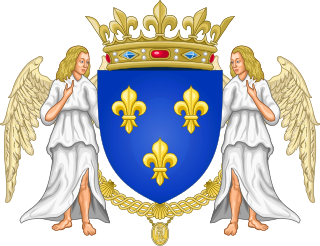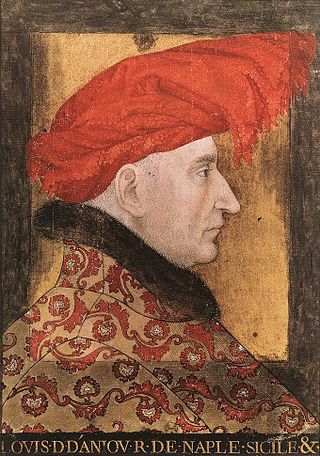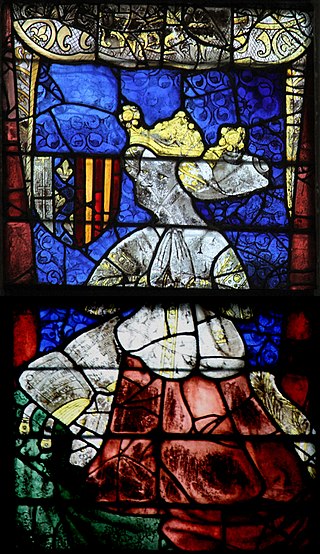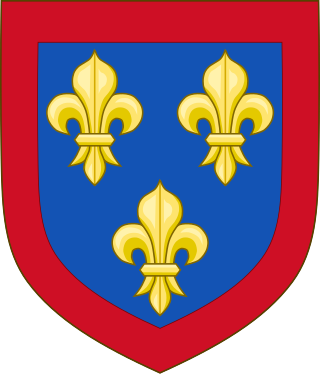See also
Topics referred to by the same term
This disambiguation page lists articles about people with the same name. If an internal link led you here, you may wish to change the link to point directly to the intended article.
Louis of Valois (French: Louis de Valois) may refer to:
The Capetian dynasty, also known as the House of France, is a dynasty of Frankish origin, and a branch of the Robertians. It is among the largest and oldest royal houses in Europe and the world, and consists of Hugh Capet, the founder of the dynasty, and his male-line descendants, who ruled in France without interruption from 987 to 1792, and again from 1814 to 1848. The senior line ruled in France as the House of Capet from the election of Hugh Capet in 987 until the death of Charles IV in 1328. That line was succeeded by cadet branches, the Houses of Valois and then Bourbon, which ruled without interruption until the French Revolution abolished the monarchy in 1792. The Bourbons were restored in 1814 in the aftermath of Napoleon's defeat, but had to vacate the throne again in 1830 in favor of the last Capetian monarch of France, Louis Philippe I, who belonged to the House of Orléans. Cadet branches of the Capetian House of Bourbon house are still ruling over Spain and Luxembourg.

The House of Bourbon is a European dynasty of French origin, a branch of the Capetian dynasty, the royal House of France. Bourbon kings first ruled France and Navarre in the 16th century. By the 18th century, members of the Spanish Bourbon dynasty held thrones in Spain, Naples, Sicily, and Parma. Spain and Luxembourg have monarchs of the House of Bourbon.

The Capetian house of Valois was a cadet branch of the Capetian dynasty. They succeeded the House of Capet to the French throne, and were the royal house of France from 1328 to 1589. Junior members of the family founded cadet branches in Orléans, Anjou, Burgundy, and Alençon.

Charles VI, nicknamed the Beloved and later the Mad, was King of France from 1380 until his death in 1422. He is known for his mental illness and psychotic episodes that plagued him throughout his life.

René of Anjou was Duke of Anjou and Count of Provence from 1434 to 1480, who also reigned as King of Naples as René I from 1435 to 1442. Having spent his last years in Aix-en-Provence, he is known in France as the Good King René.
Duke of Orléans was a French royal title usually granted by the King of France to one of his close relatives, or otherwise inherited through the male line. First created in 1344 by King Philip VI for his younger son Philip, the title was recreated by King Charles VI for his younger brother Louis, who passed the title on to his son and then to his grandson, the latter becoming King Louis XII. The title was created and recreated six times in total, until 1661, when Louis XIV bestowed it upon his younger brother Philippe, who passed it on to his male descendants, who became known as the "Orléans branch" of the Bourbons.

Duke of Bourbon is a title in the peerage of France. It was created in the first half of the 14th century for the eldest son of Robert of France, Count of Clermont, and Beatrice of Burgundy, heiress of the lordship of Bourbon. In 1416, with the death of John of Valois, the Dukes of Bourbon were simultaneously Dukes of Auvergne.

Louis II was Duke of Anjou and Count of Provence from 1384 to 1417; he claimed the Kingdom of Naples, but only ruled parts of the kingdom from 1390 to 1399. His father, Louis I of Anjou—the founder of the House of Valois-Anjou—was a younger son of King John II of France and the adopted son of Queen Joanna I of Naples. When his father died during a military campaign in Naples in 1384, Louis II was still a child. He inherited Anjou from his father, but his mother, Marie of Blois, could not convince his uncles, John, Duke of Berry and Philip II, Duke of Burgundy, to continue her husband's war for Naples. The Provençal nobles and towns refused to acknowledge Louis II as their lawful ruler, but Marie of Blois persuaded them one after another to swear fealty to him between 1385 and 1387.

Yolande of Aragon was Duchess of Anjou and Countess of Provence by marriage, who acted as regent of Provence during the minority of her son. She was a daughter of John I of Aragon and his wife Violant of Bar. Yolande played a crucial role in the struggles between France and England, influencing events such as the financing of Joan of Arc's army in 1429 that helped tip the balance in favour of the French. She was also known as Yolanda de Aragón and Violant d'Aragó. Tradition holds that she commissioned the famous Rohan Hours.
Charles d'Orléans may refer to:
Philip of France might refer to:
Louis of France or Louis de France may refer to:
Charles of France might refer to:

The House of Valois-Anjou was a noble French family and cadet branch of the House of Valois. Members of the house served as monarchs of Naples, as well as several other territories.

Margaret of Anjou was Countess of Anjou and Maine in her own right and Countess of Valois, Alençon and Perche by marriage. Margaret's father was King Charles II of Naples, whilst her husband was Charles, Count of Valois, and her older brother was Saint Louis of Toulouse; her nephew was King Charles I of Hungary.

The term House of France refers to the branch of the Capetian dynasty which provided the Kings of France following the election of Hugh Capet. The House of France consists of a number of branches and their sub-branches. Some of its branches have acceded to the Crown, while others remained cadets.